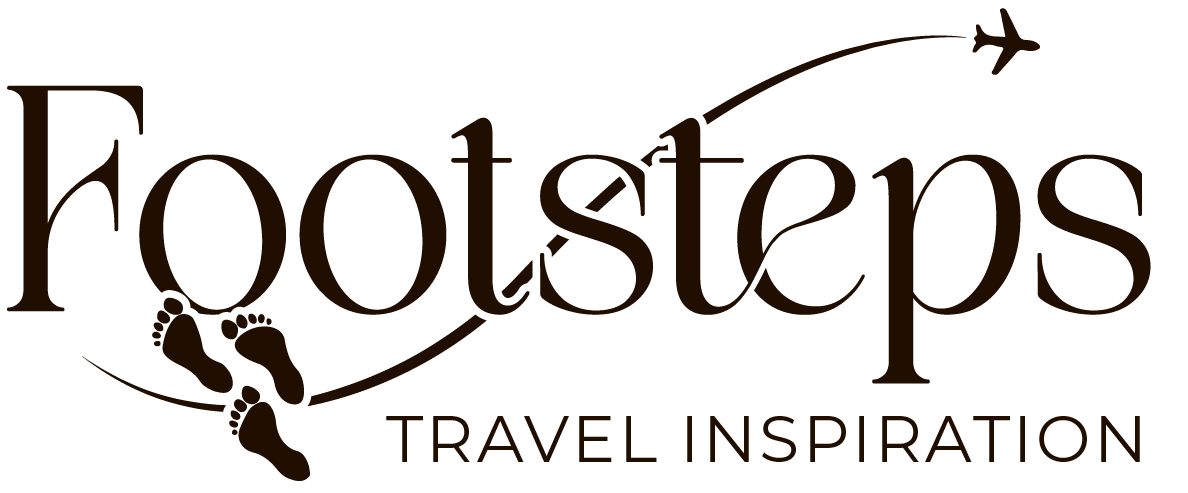Elephant Hills is a jungle adventure camp in Khao Sok national park, Thailand.
They call it a ‘soft’ adventure, which I think is a good description of the balance they’ve created of spending time in the beautiful natural environment of the Khao Sok jungle, but in a way that’s comfortable, suitable for families and people of all ages and abilities – and fully catered.
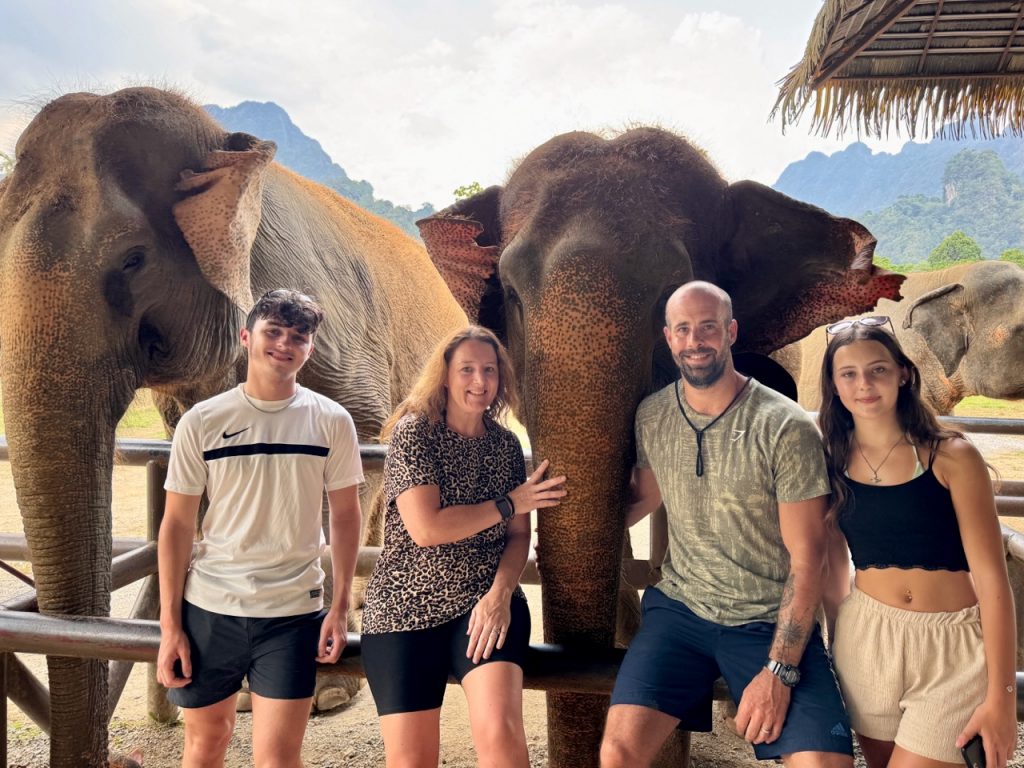
Elephant Hills has a range of different packages depending on how many nights you stay – from 2 to 4 nights and whether you do an excursion to their ‘lake camp’, but each option involves a variety of jungle ‘experiences’ like canoe trips, jungle trekking and the main highlight, their elephant encounter experience.
If you’re visiting Elephant Hills, it’s likely you’ll do so as part of a longer visit to Thailand, so they lay on full door-to-door transport, collecting you from wherever you’re staying and dropping you back to wherever you’re travelling next.
We were picked up by their minibus driver from our hotel in Phuket at about 8am and driven the approximately three hour journey to the main Elephant Hills jungle camp in Khao Sok – a journey which was very smooth and straightforward, with only one other family on the minibus and an enjoyable, scenic drive through beautiful jungle scenery.
It was a very warm welcome when we arrived at the camp, as we were greeted by Deen who would be our guide for the various expeditions we’d do over the next three days and who quickly made sure we were given some welcome drinks and all our luggage was taken care of.
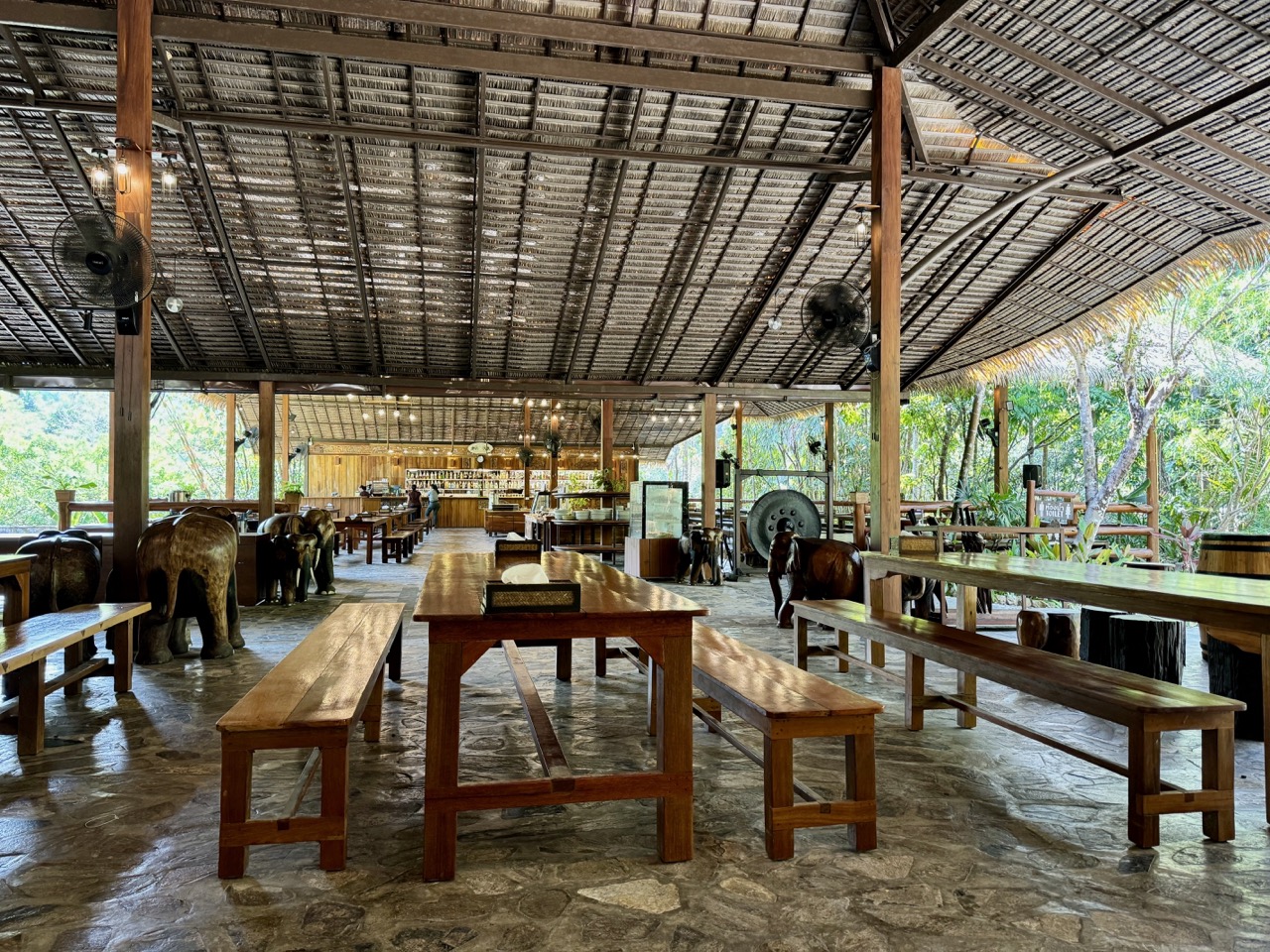
We sat in the main camp reception area, which is a huge under-cover area with rows of large tables and a bar serving drinks at the far end.
It serves as the main meeting area for the camp as well as the restaurant where they serve up delicious buffet breakfasts, lunches and dinners.
We got a great first-impression of Elephant Hills here, with the friendly guides chatting and welcoming everyone, the clean and high quality nature of the facilities but, most of all, the beautiful scenery with gigantic cliff faces rising out of the jungle that surrounded us.
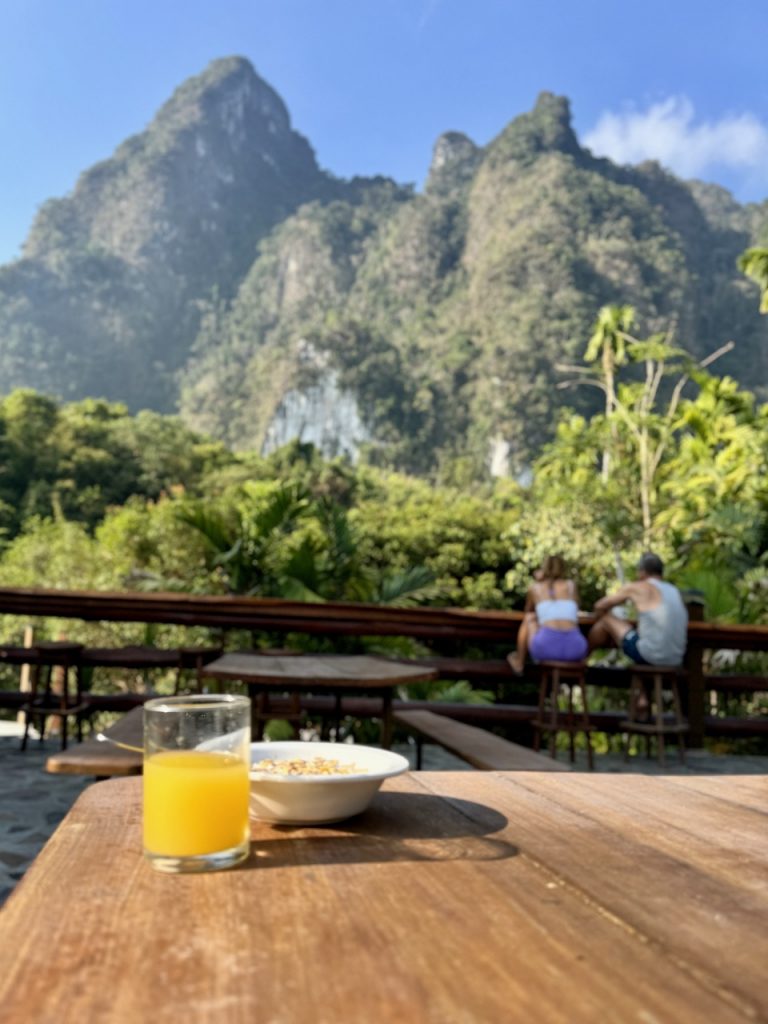
After a brief introduction and explanation of what to expect, we were given our tent keys and told we had two hours or so to head off to our tent, unpack, explore the camp, have some lunch and relax before our first activity of the stay, for which we had to meet back at the reception area.
I have to admit I’d been a bit worried about coming to Elephant Hills, as it was all booked and planned by my wife who knows that one of my least favourite things to do is camping – and I hadn’t been looking forward to staying in a tent after a fortnight of enjoying being at nice hotels around Bangkok, Krabi and Phuket.
I quickly realised as we walked through the jungle camp looking for our tent that I had nothing to worry about – and the tents at Elephant Hills are nothing like the kind of tent I was imagining or had experienced before.
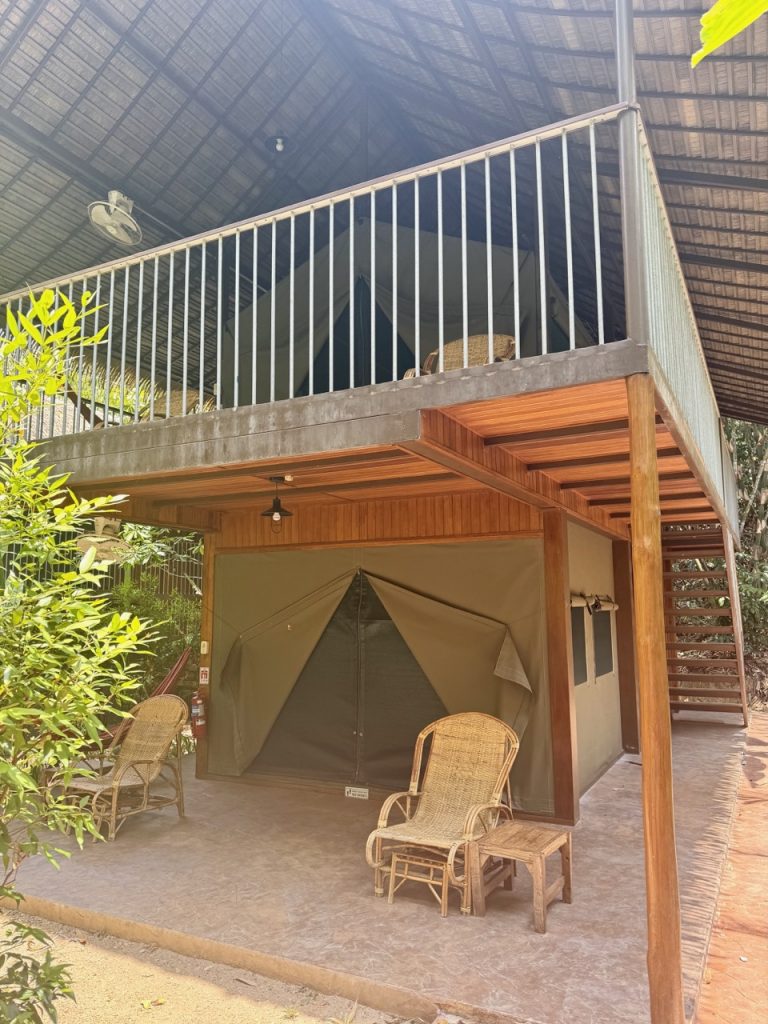
I’m not even sure “glamping” is the right word to describe it – as the Elephant Hills tents are almost more like detached houses than tents.
Each tent is built on solid concrete foundations with solid wood floors and with a solid roof meaning you’re 100% protected from the elements.
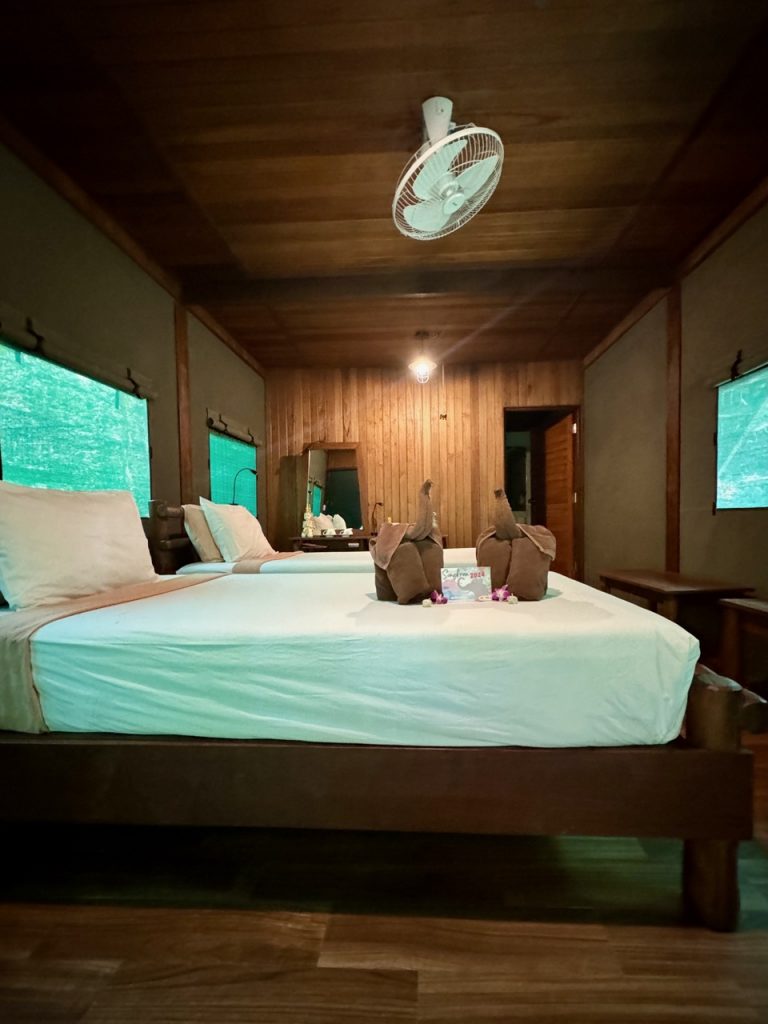
The inner ‘shell’ is canvas, so you do have canvas walls and a canvas roof but it’s all within a solid outer construction.
Ours was two stories, with the children staying downstairs and us upstairs – each with proper, full-sized, off-the-floor beds (no sleeping bags or anything like that), electricity, lighting, a separate bathroom and shower on each floor of each tent with fully running hot water and full-sized flushing toilets.
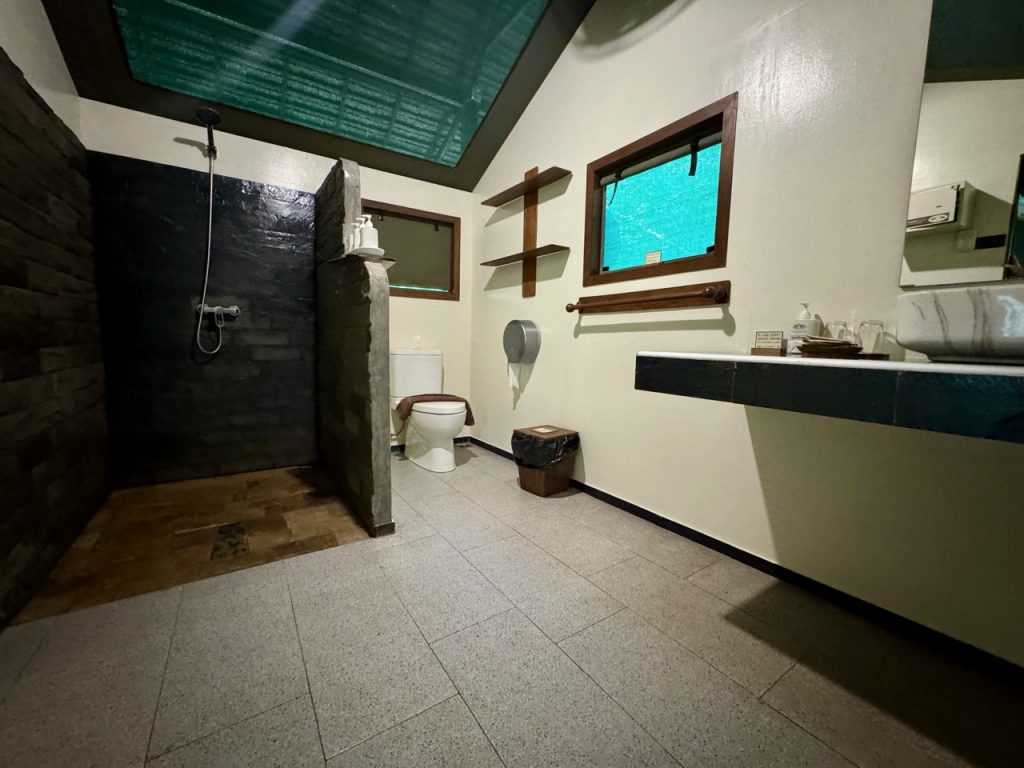
No queuing up at shared toilet and shower blocks like I was picturing – this is nothing like the kind of campsite I’d stayed at before and I think the accommodation is probably closer to that of a hotel than of a tent in the way you might usually think of one.
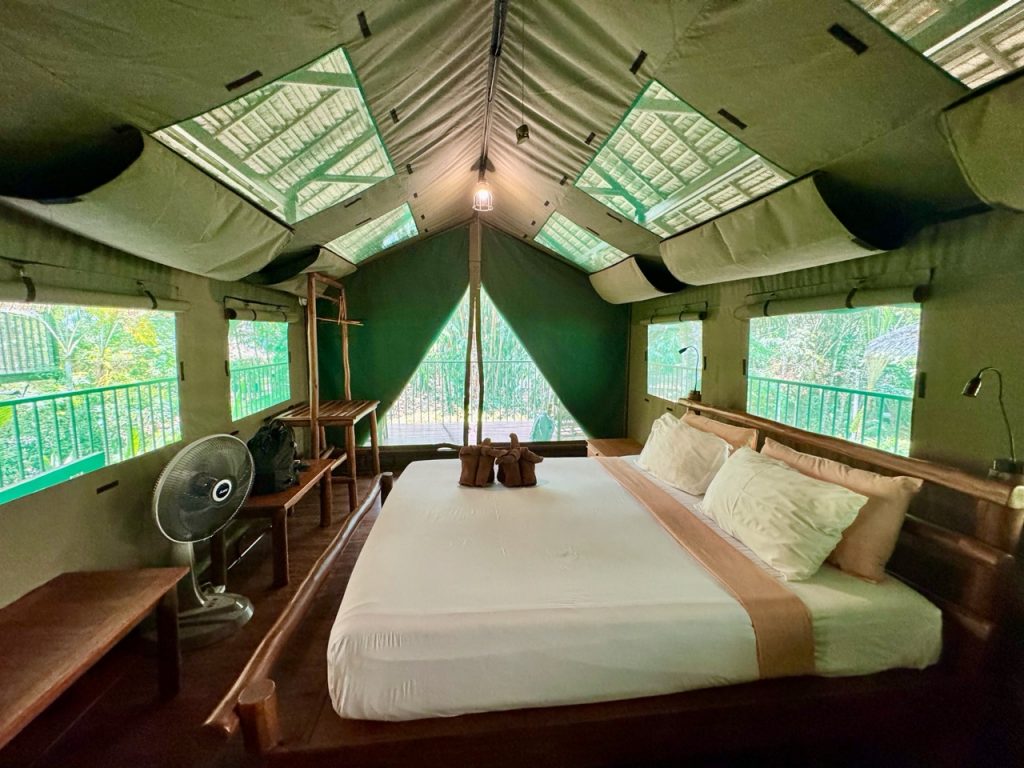
Each tent is in its own separate gated area and has an outside terrace / balcony with chairs and a hammock.
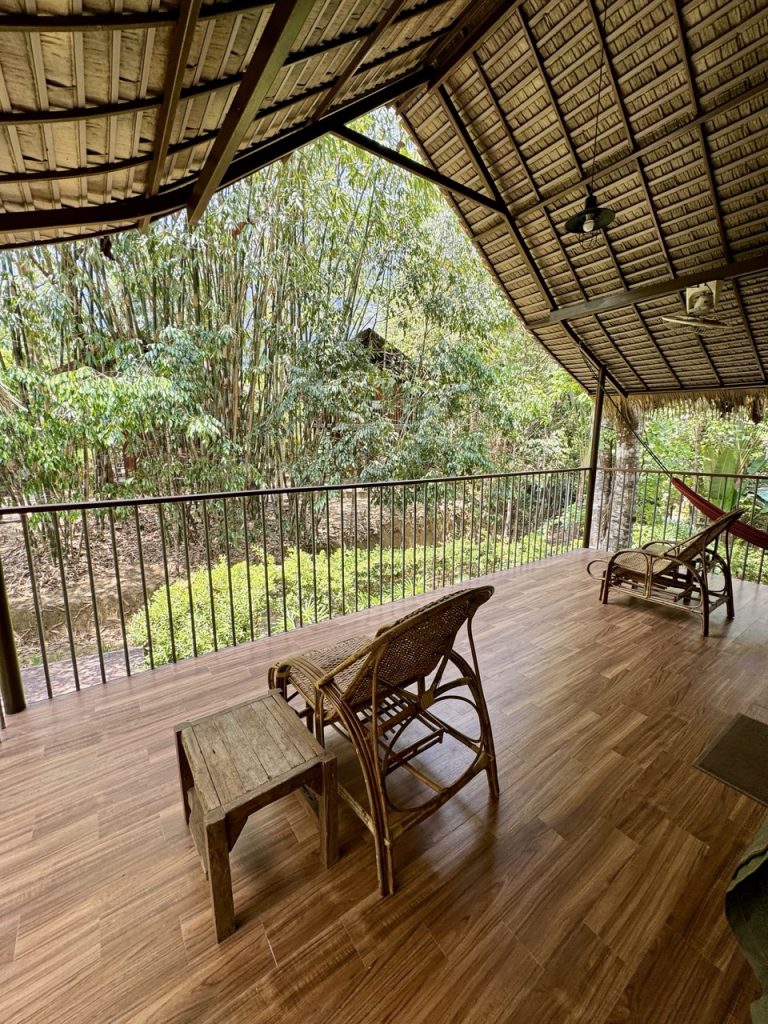
I felt the accommodation was a perfect balance of being comfortable and easy to live in, but still feeling a bit like you’re camping out in the jungle wilderness.
You still hear the sounds of nature all around you through your canvas walls – the noises of the jungle insects and creatures at night but with all the benefits of a comfortable double bed and shower, toilet, electricity and wifi!
After settling in and recharging after the long drive here, we headed up to the meeting area for our first excursion, which was to be a river canoe trip.
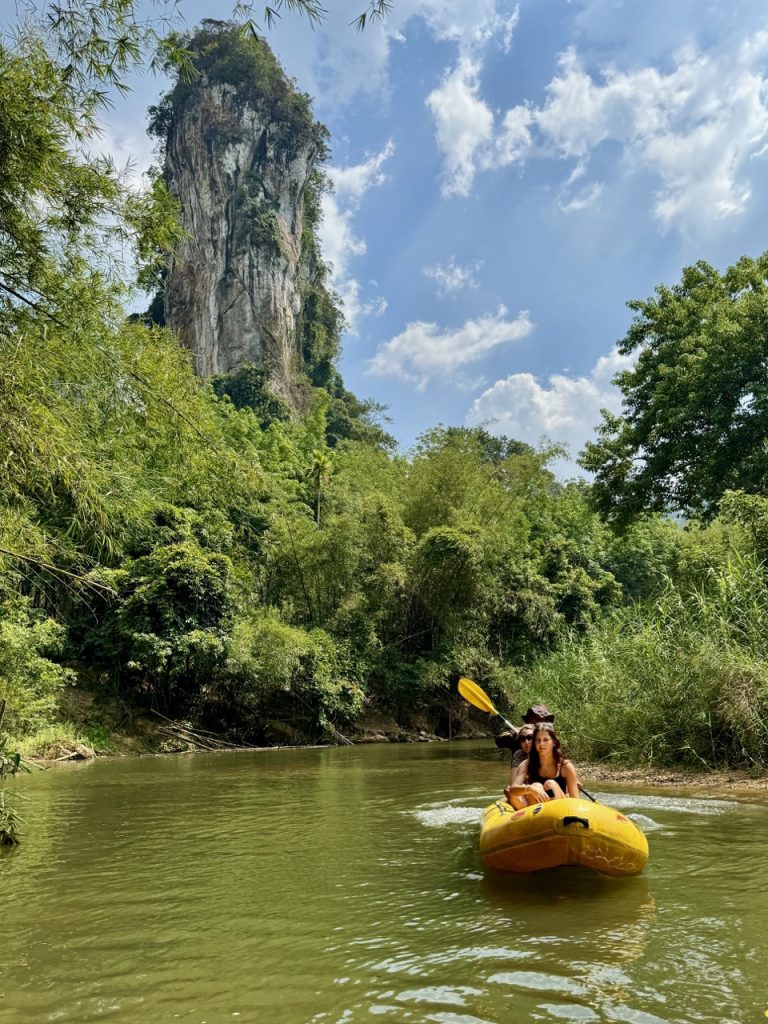
I’m not sure how many people were staying at Elephant Hills while we were here in April, but looking around the camp buffet area at peak times I’d say maybe there were a couple of hundred people – mainly families.
But when we were split up into groups for our excursions, it felt like we were almost the only ones here – as each group was very small (I don’t think we had more than 10 people in a group at any time) and each group was completely separate from the others, meaning there were never crowds of people and it had a very personal, relaxed feel the whole time.
For the canoe trip, we were taken in a small truck out of the camp and just down the road to a meeting point, where a group of ‘paddle men’ were waiting in inflatable canoes.
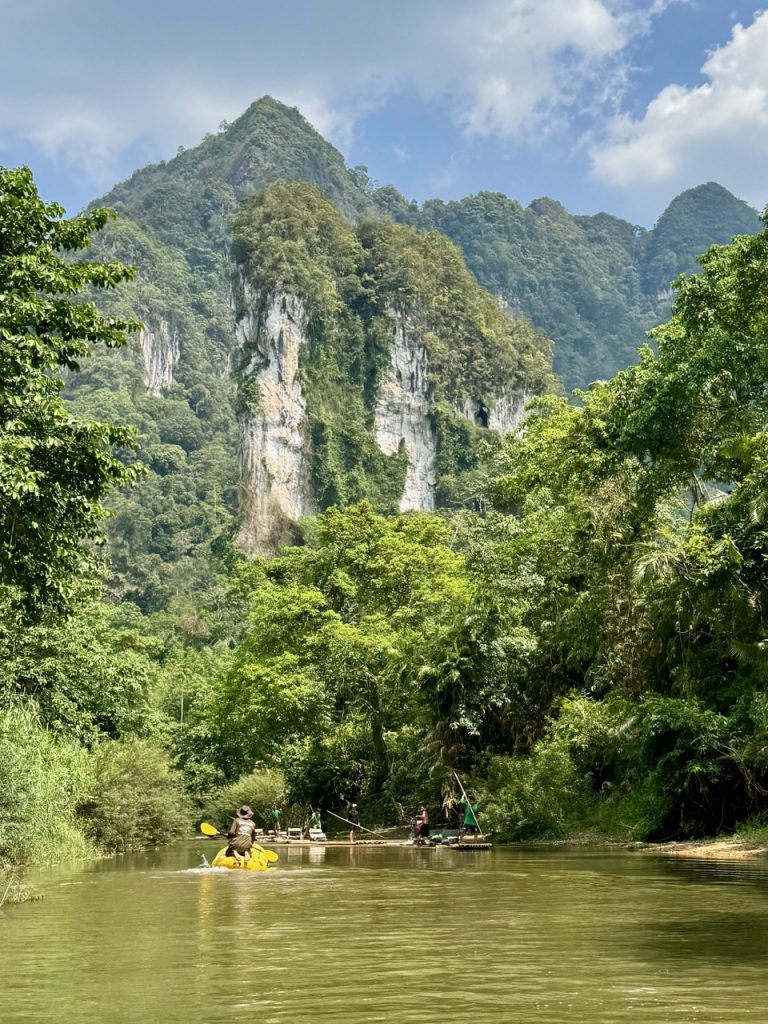
We got in – two per canoe – and headed serenely off down the river, floating through this awesome jungle scenery on the lookout for wildlife on the river banks.
The paddle-men pointed out lizards and frogs; we floated past local kids cooling off and playing in the river – and the guides helped us take photos of ourselves in the canoes and the amazing scenery around us.
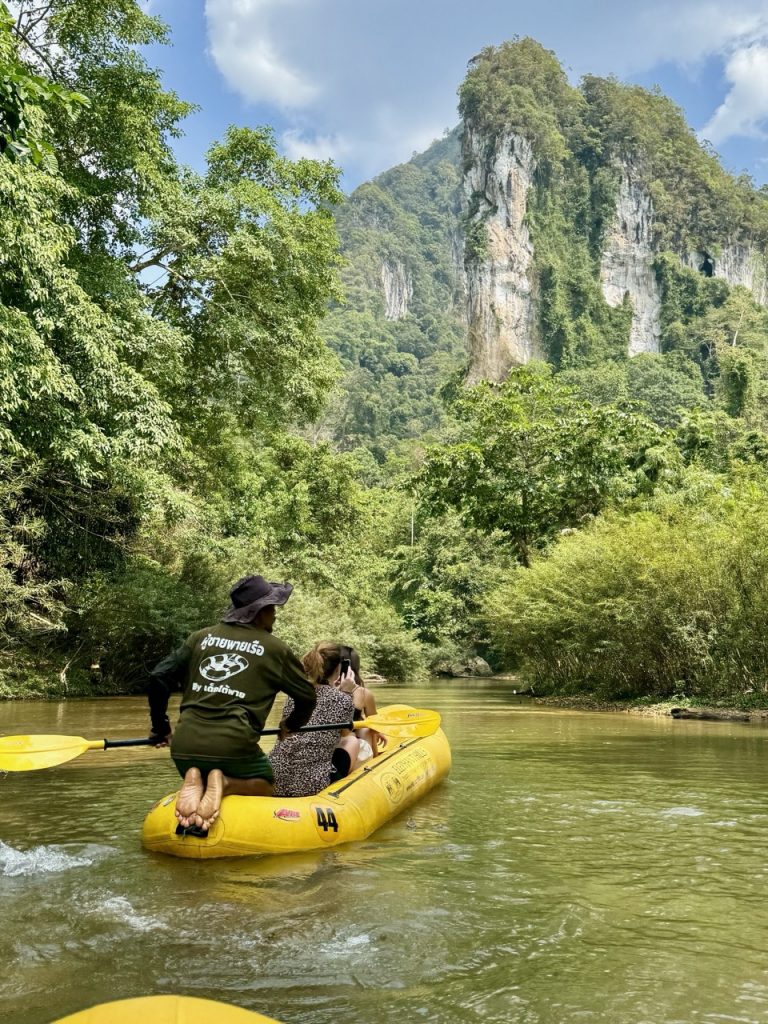
About half way through we spotted a family of monkeys playing in the trees on the riverbank. The paddle-men took us as close as they could and the monkeys seemed unconcerned about us floating around nearby, watching them chasing each other around the river bank and up into the trees.
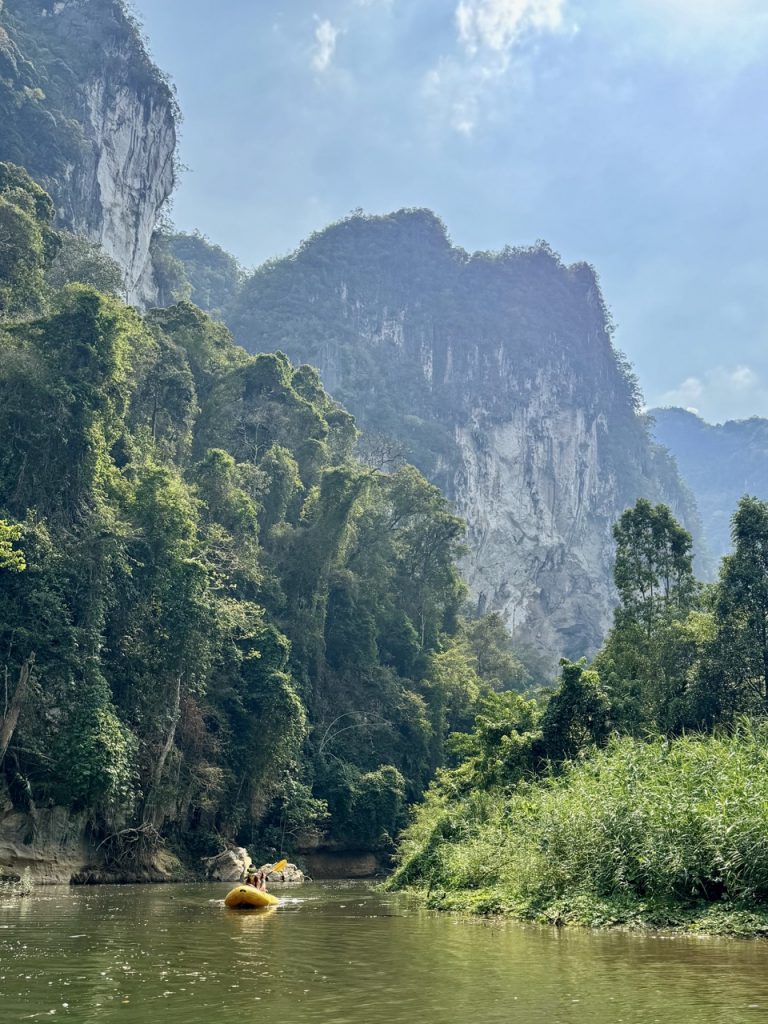
This was superb – and exactly what we’d hoped for when booking Elephant Hills. Seeing creatures like these awesome monkeys out in the wild, in their natural habitat, up-close – it absolutely made our day and was a great memory for us.
I don’t know how long we were out on the river for, we lost track of time as we were enjoying it so much, though after seeing the monkeys we didn’t come across any other wildlife – we just enjoyed the peaceful ride and the amazing views until we reached the river bank where the truck was waiting to take us back to the camp.
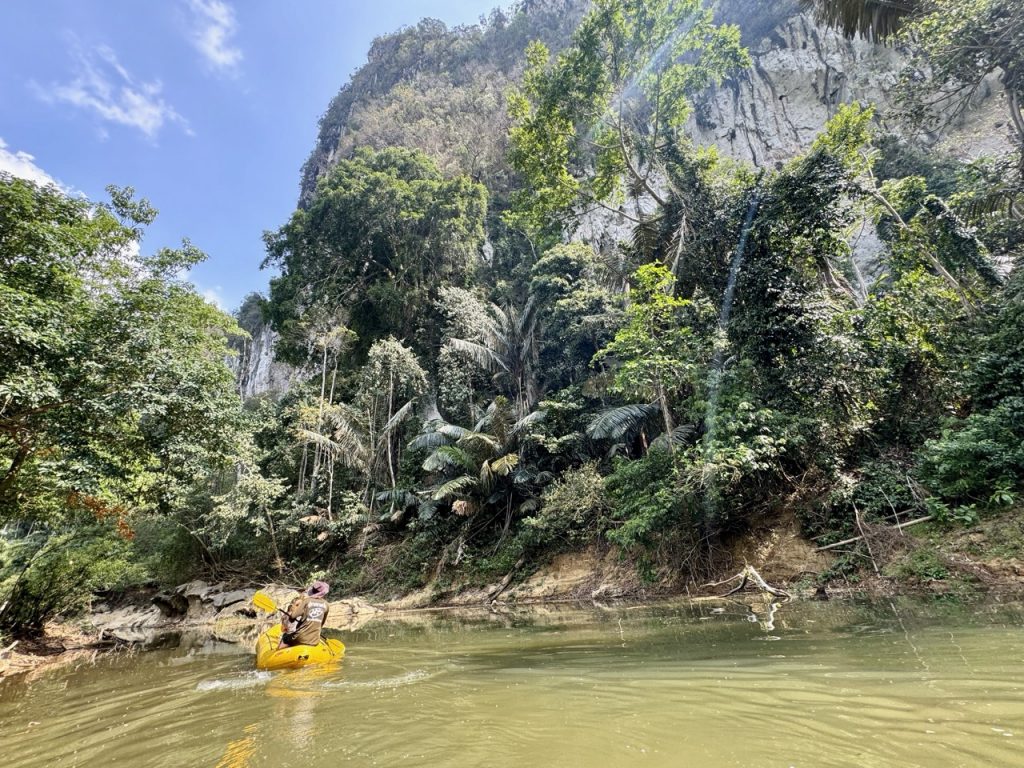
We were in a great mood as we sat with a drink in the main camp meeting area waiting for our next excursion later in the afternoon.
We felt like we were out in the jungle enjoying Thailand’s awesome nature, we’d been watching wild monkeys and were about to go and see a herd of elephants, but also we were sat with a cold beer and a cocktail having just had a hot shower in our own jungle house!
This is what they mean by ‘soft adventure’, experiencing the wild nature of the Thai jungle, but with the comforts of an all-inclusive hotel – and I have to say by this point, we were loving it.
Our next excursion was the one we’d been most looking forward to, which was to see the eponymous elephants, which live in an enclosure about 10-minutes drive from the camp.
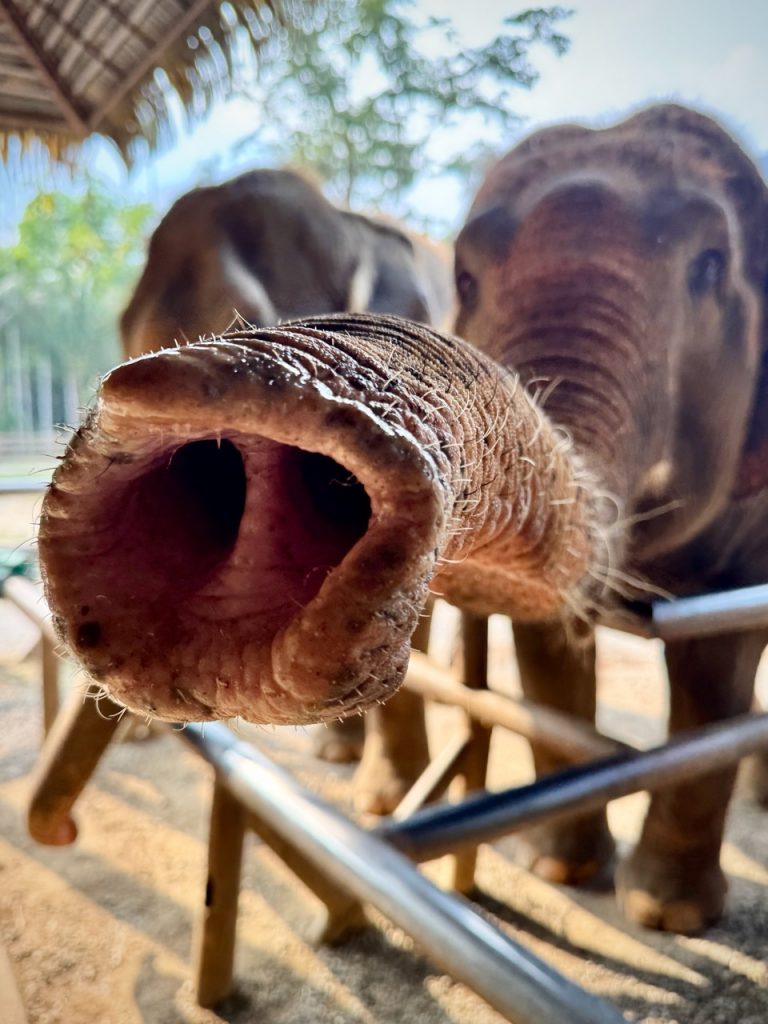
We learned from a documentary they showed us that Thailand has thousands of elephants but the majority of them are domesticated rather than wild.
Apparently over the centuries, the Thai people captured and bred the elephants, training them mainly for use in the logging trade – something which was banned in the 1980s, leaving thousands of domesticated elephants which couldn’t be returned to the wild, but which still need housing, feeding and caring for.
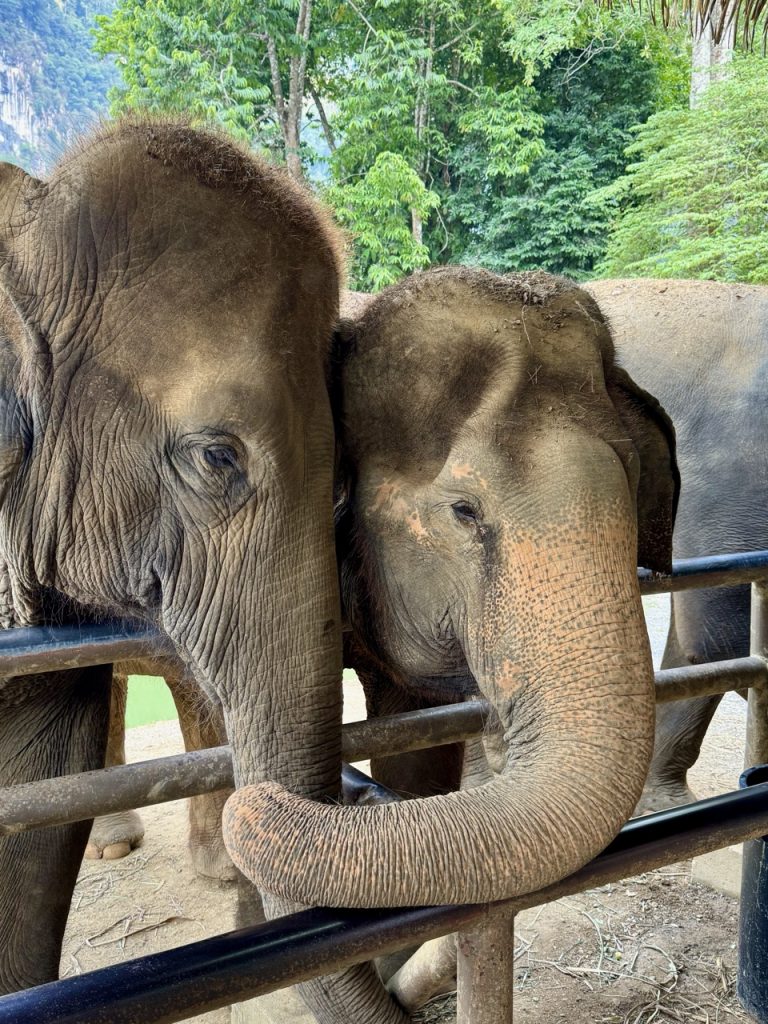
Unfortunately many elephants are used in the tourist trade for things like elephant rides or elephant encounters in captive enclosures which are un-natural and to be honest look pretty cruel.
You see them as you drive around parts of Thailand chained up by the ankles, unable to move freely around and forced to carry tourists on their backs, which is un-natural to them.
So Elephant Hills have tried to create a habitat that gives a herd of rescued, domesticated elephants an environment as close to their natural one as possible, where tourists can come and interact with them in a way the elephants enjoy (i.e. being fed) while the rest of the time they roam around unchained and relatively free to do what they want.
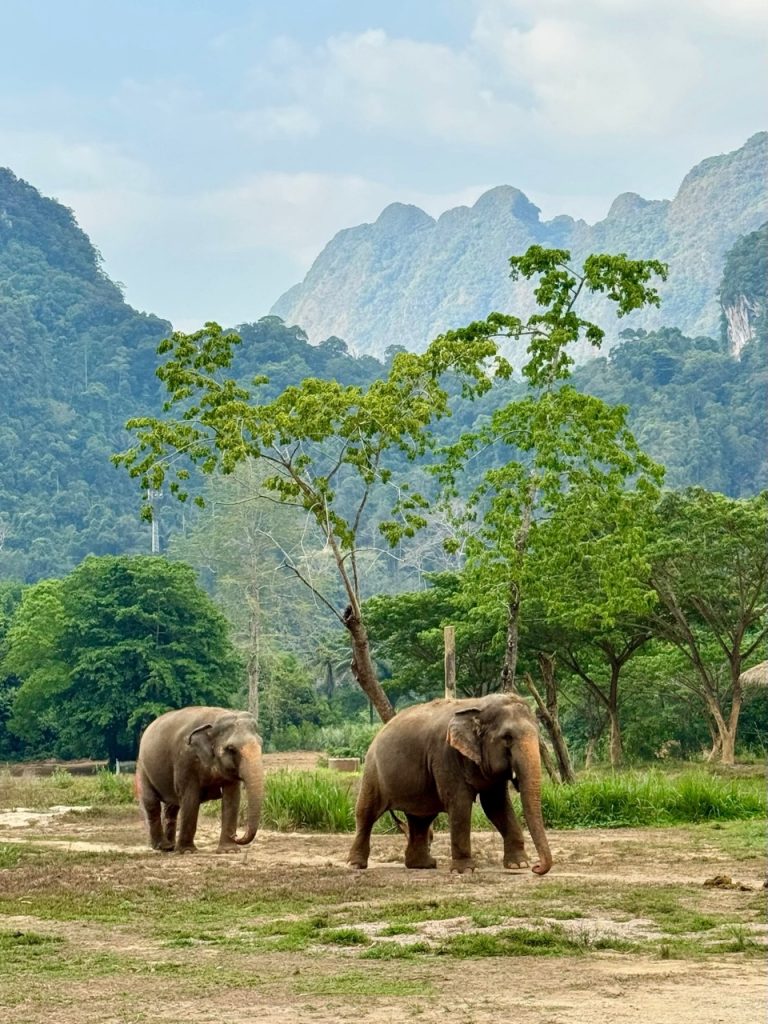
When we arrived at the elephant camp, we saw all the elephants already hanging around the main feeding area, waiting patiently whilst the guides chopped up pineapples and bamboo and various other foods ready for us to hand-feed them for their dinner.
We had time to get up close to the amazing creatures, stroking them and posing for photos with them, which they all seemed happy to let us do completely voluntarily.
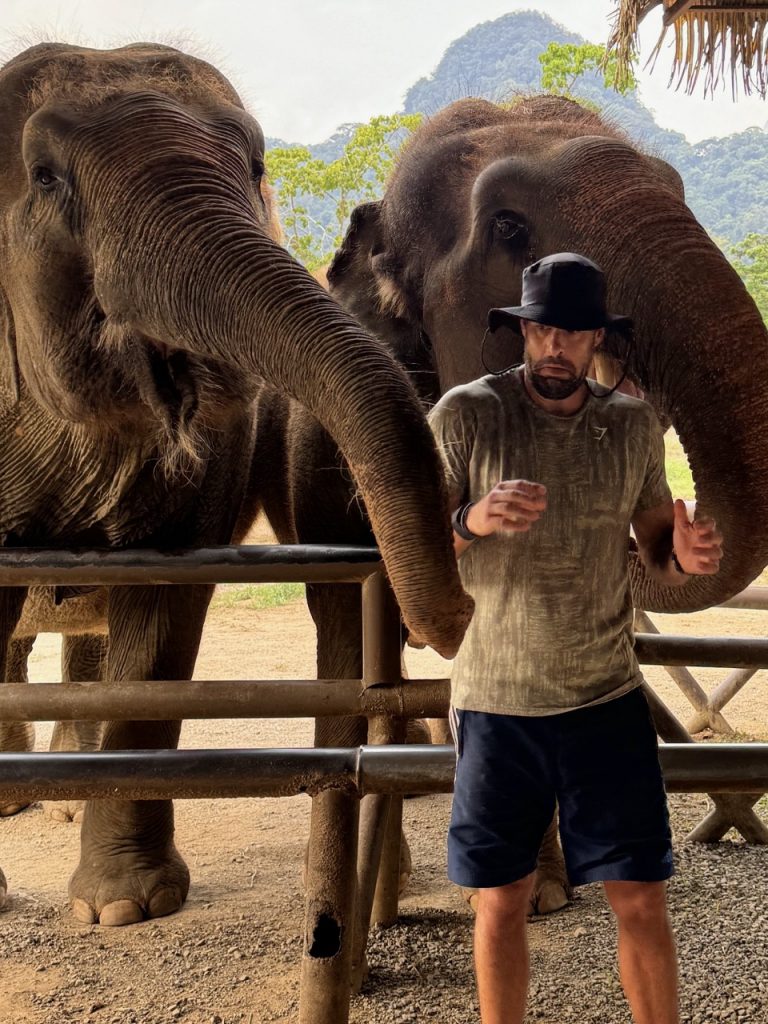
Really they were just hanging around with us because they knew their dinner was being prepared and they were about to get fed – and it was amazing to be able to get this close and interact so personally with the elephants without having to see them being chained up or forced into un-natural behaviour like we’d witnessed elsewhere on our Thailand trip.
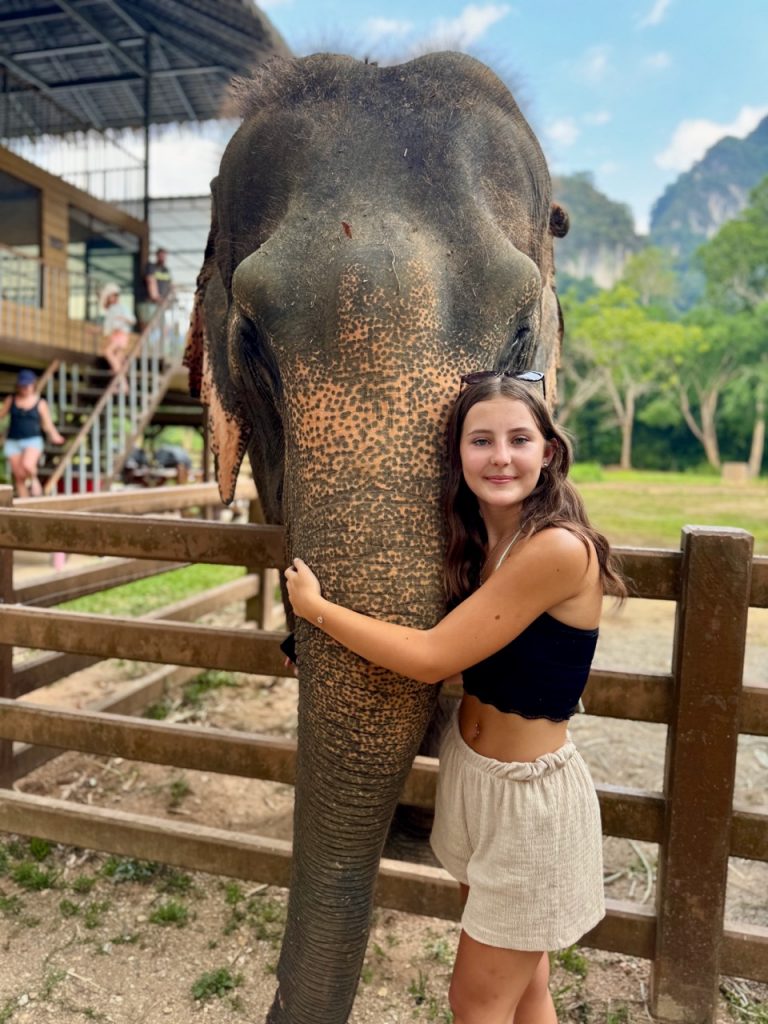
Each of us had a basket of food that we could go around and feed to whichever of the elephants we wanted.
The guides told us the stories of each elephant, every one with their own unique personalities, all of them appearing friendly and eager to snatch food from our hands with their massive trunks.
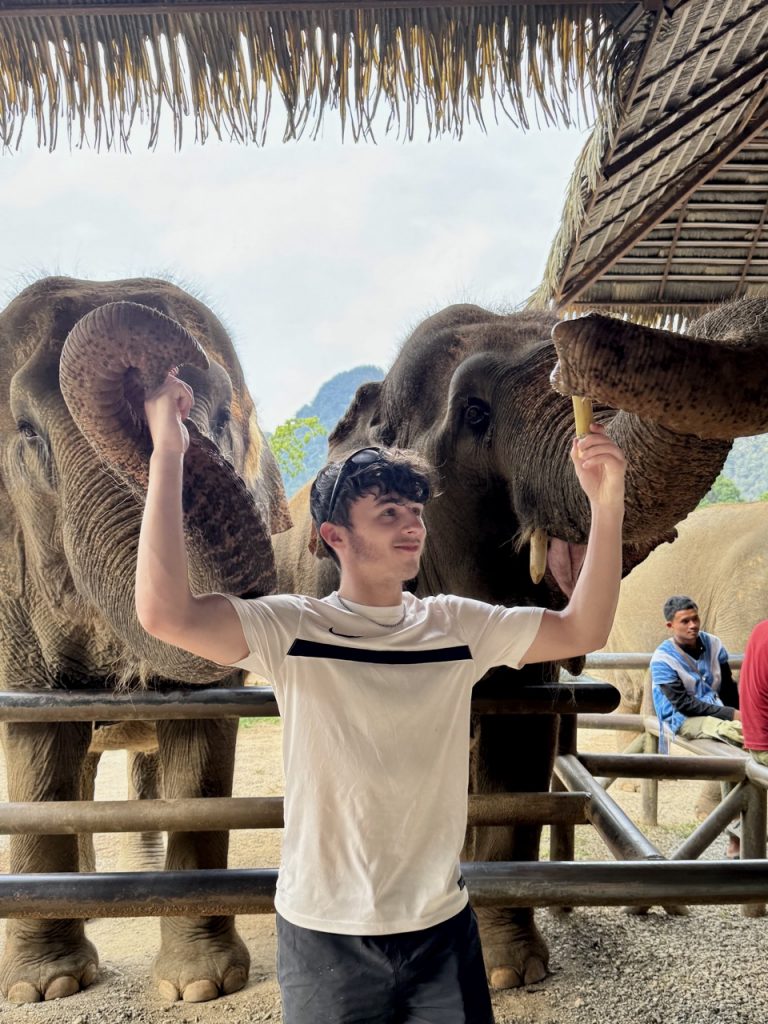
It was absolutely amazing – really one of the best experiences we’ve had on a holiday, the only down-side being it was over too soon.
We hung around and watched the elephants head into their lake, swimming and spraying water around before eventually they were led off back to their living area and we headed off back to the camp.
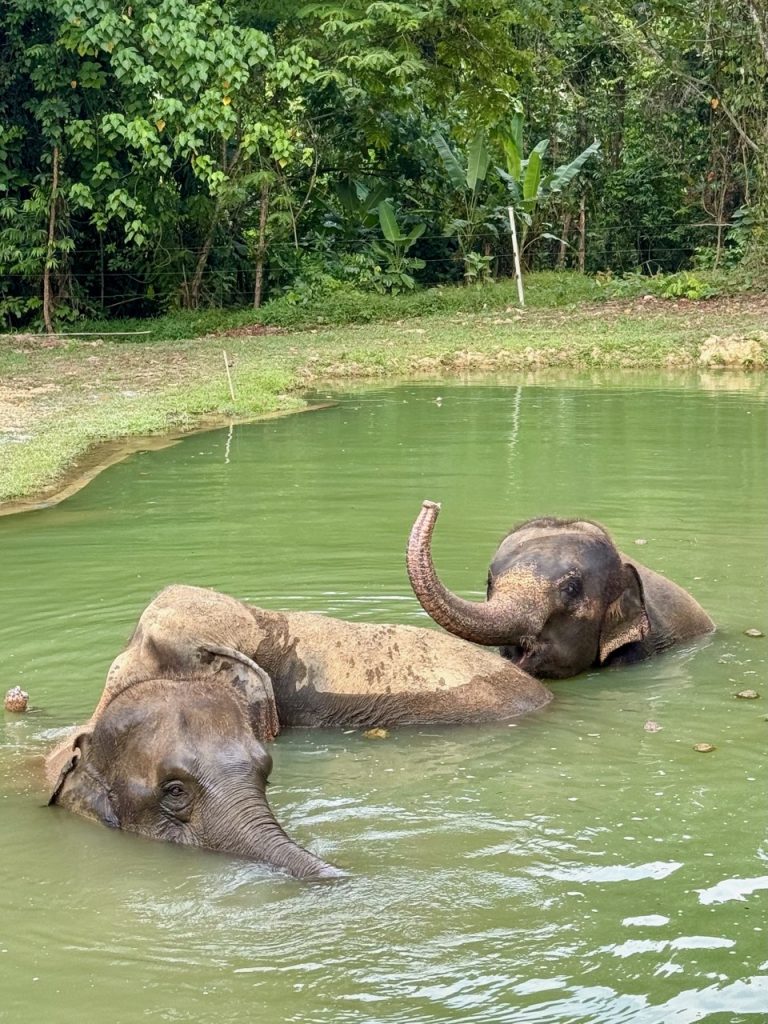
Personally, I wish we could’ve done more with the elephants – we’d have happily spent a whole day doing anything to help look after them and spend time with them as they were so awesome, fun and incredible to be so up close with.
But of course there are hundreds of other visitors to Elephant Hills so there’s a schedule they have to stick to so everyone gets equal time with them in a way that fits in with the elephants’ natural day too.
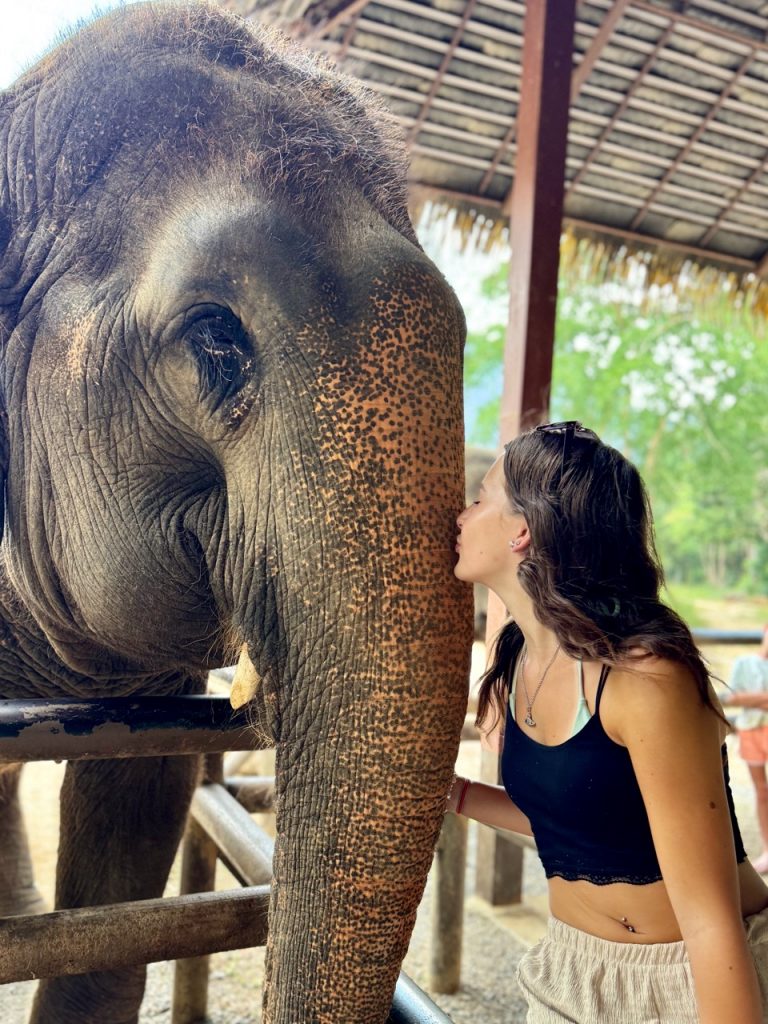
After this we were shown a short documentary film about the history of Thailand’s elephants and the preservation efforts before heading back to the camp with time to relax at the pool and the tent ready for dinner time.
All meals are included in the cost at Elephant Hills and every evening they sound a gong to announce to the camp that the buffet is open.
We were very pleased with the food on offer – there was a great selection of Thai and western food to suit all requirements and every meal we had here was delicious, and there was plenty of it too.
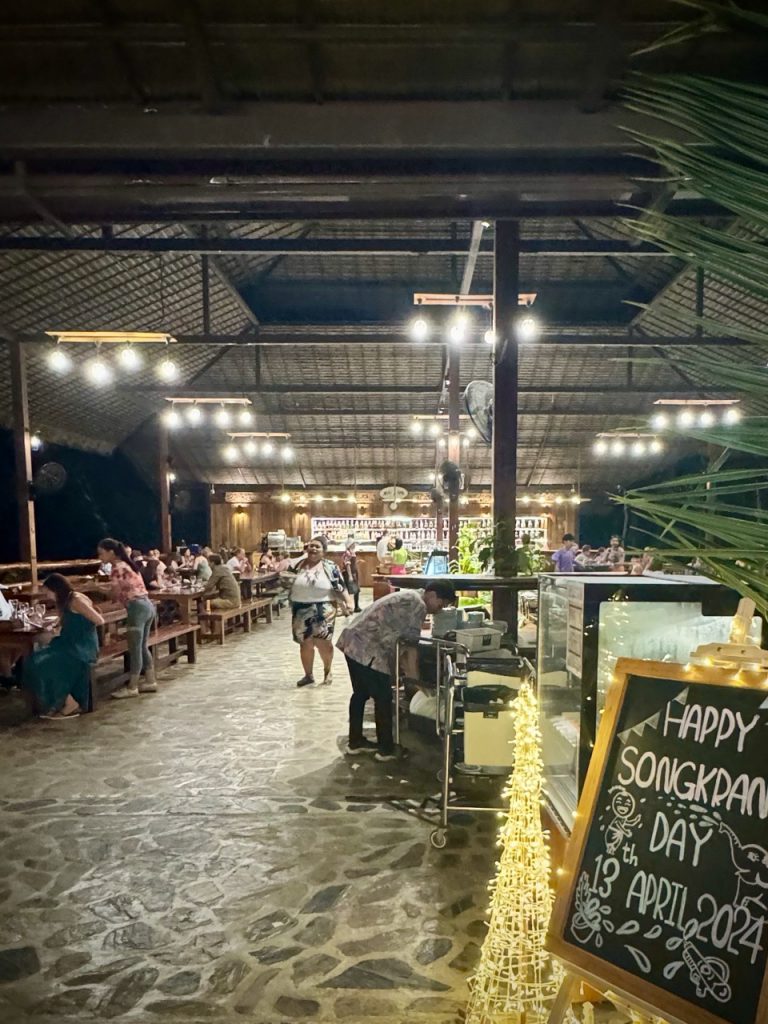
There was a great atmosphere about the camp at dinner times and the guides would put on various bits of entertaining activity for anyone wanting to take part, like cooking demonstrations or prize raffles or even Thai dancing lessons and so on.
Or you can simply sit and relax with a drink from the bar (drinks aren’t included in the cost, you do have to pay for those separately) and enjoy the warm jungle evenings in the stunning surroundings.
Day two for us was a trip to the separate Elephant Hills ‘lake camp’ at Cheow Lan Lake.
Some people stay the night at the lake camp, but our itinerary was just for a day-trip, so we were up early ready to board the minibus for the trip to the lake.
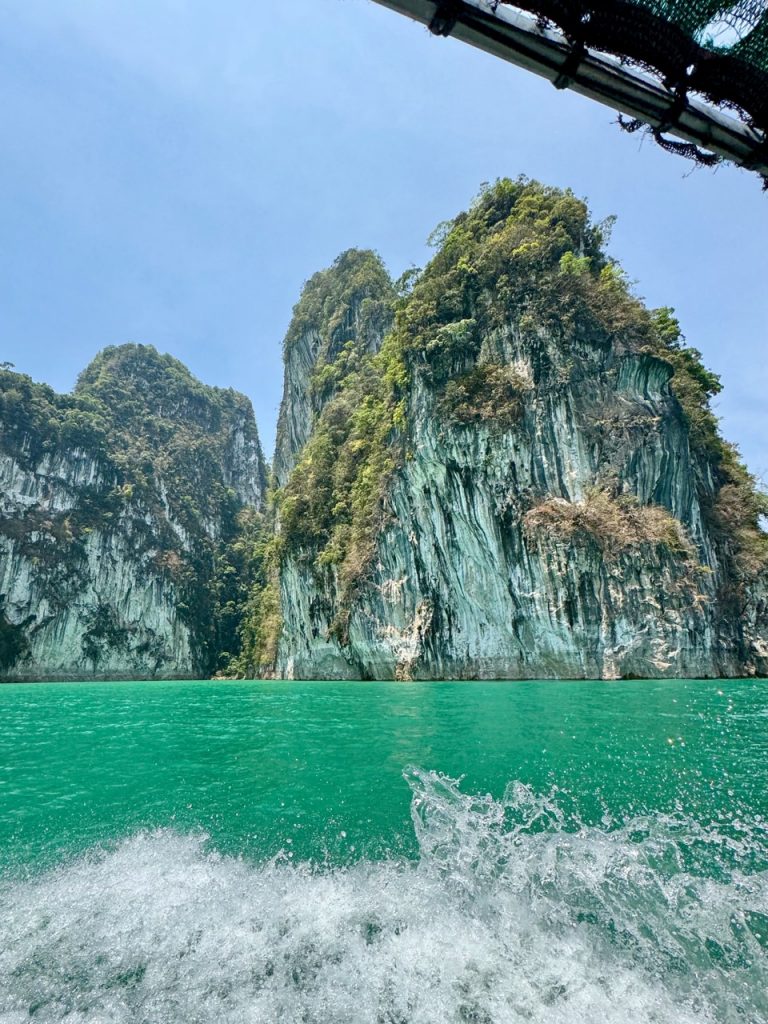
Again, we were put into a small group with just a couple of other travellers and accompanies by our guide Dean, driving through lush jungle scenery until we reached Rajjaprabha Dam – a large hydro-electric dam, where we stayed for 45-minutes or so (a part of the trip I think they could do without, as it wasn’t a very interesting stop) before then heading around to the jetty on the lake where long tail boats awaited to take us to the lake camp.
This was a beautiful part of the journey – the scenery around the lake is incredible and we had a slight detour to see the most picturesque area of high limestone cliffs descending into the lake, before heading to the far end of the lake where the Elephant Hills lake camp is.
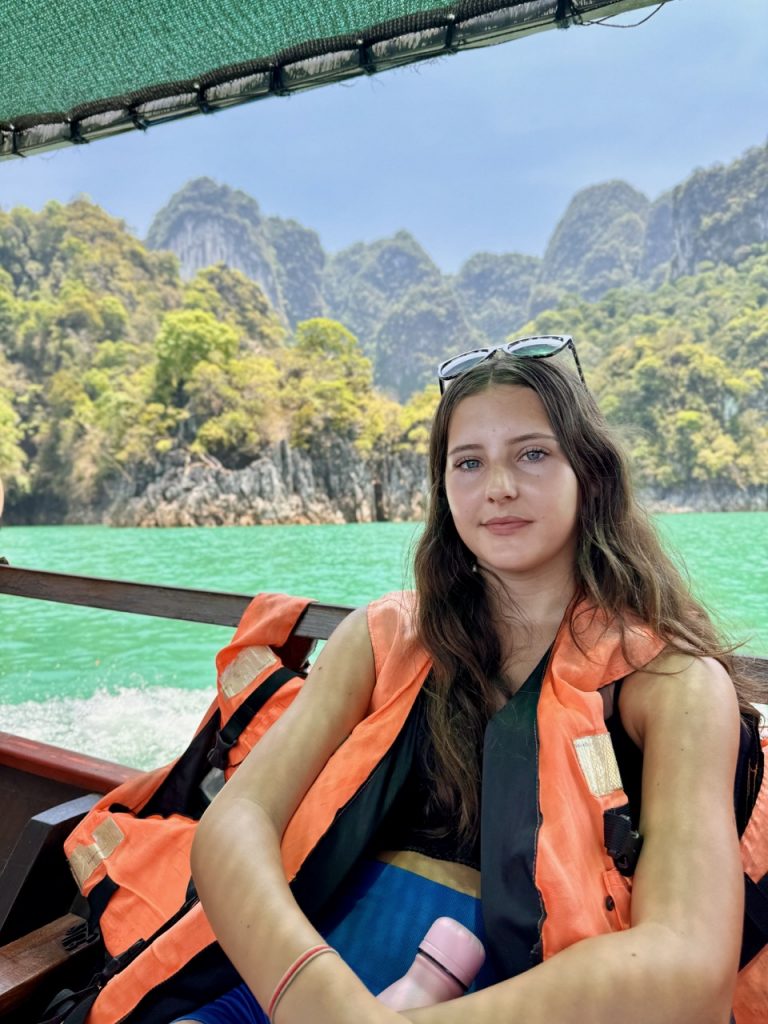
Here, in a quiet and remote part of the lake at the edge of dense jungle, Elephant Hills have a row of tents similar to those at the main camp, but which are installed on floating pontoons on the lake.
There’s also a central covered area where they serve up similar delicious buffet food and drinks to the main camp – and we had a great lunch here overlooking the tranquil, remote lake and jungle.
After lunch we were free to do whatever we wanted from a range of activities – either just sitting around sunbathing, swimming, paddle boarding or kayaking.
We chose kayaking as we were keen to head off deeper into the jungle in the hope of seeing more wildlife like the monkeys we’d seen the day before.
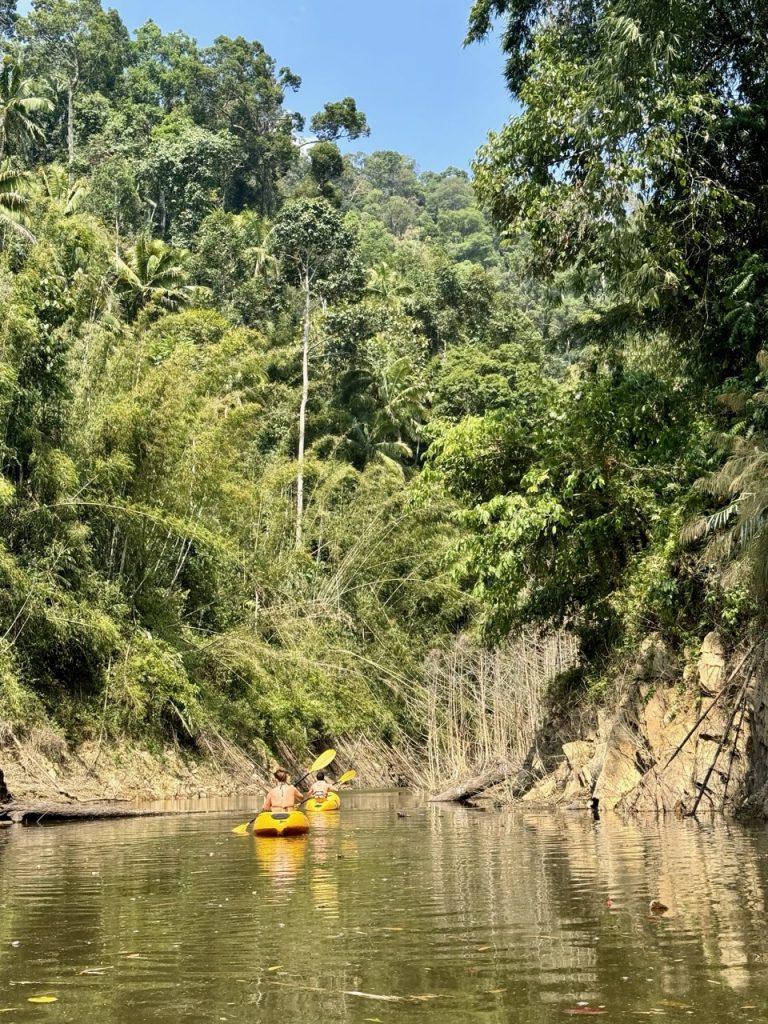
Unlike the river kayaking the day before, where we were taken down the river by a paddle-man, on the lake you’re free to paddle your own kayak and basically go wherever you want to, with some pointers from the guides as to the best places to see.
Once you’re on the lake in a kayak it seems much bigger than you first realise and we paddled like maniacs to get as far as we could into the narrow creeks that led into the more remote jungle areas.
It was absolutely dead quiet – so unbelievably peaceful and tranquil and we felt like the only people around for miles.
Unfortunately despite our best efforts scouring the trees and riverbanks all around us, we saw no further wildlife at all.
Maybe it was too hot, right at the peak of the boiling hot afternoon sun, with animals preferring to be deeper in the shadier jungle.
Still, we had a good time in the kayaks and spent the rest of the time at the lake camp swimming and relaxing before the very enjoyable long-tail boat ride back to the minibus, to get us back to the main camp in time to have another couple of hours relaxing before the evening dinner.
The next day we awoke to our final day at Elephant Hills, with time to do some packing and have breakfast before meeting for our final activity of our stay – the ‘Jungle Trekking’.
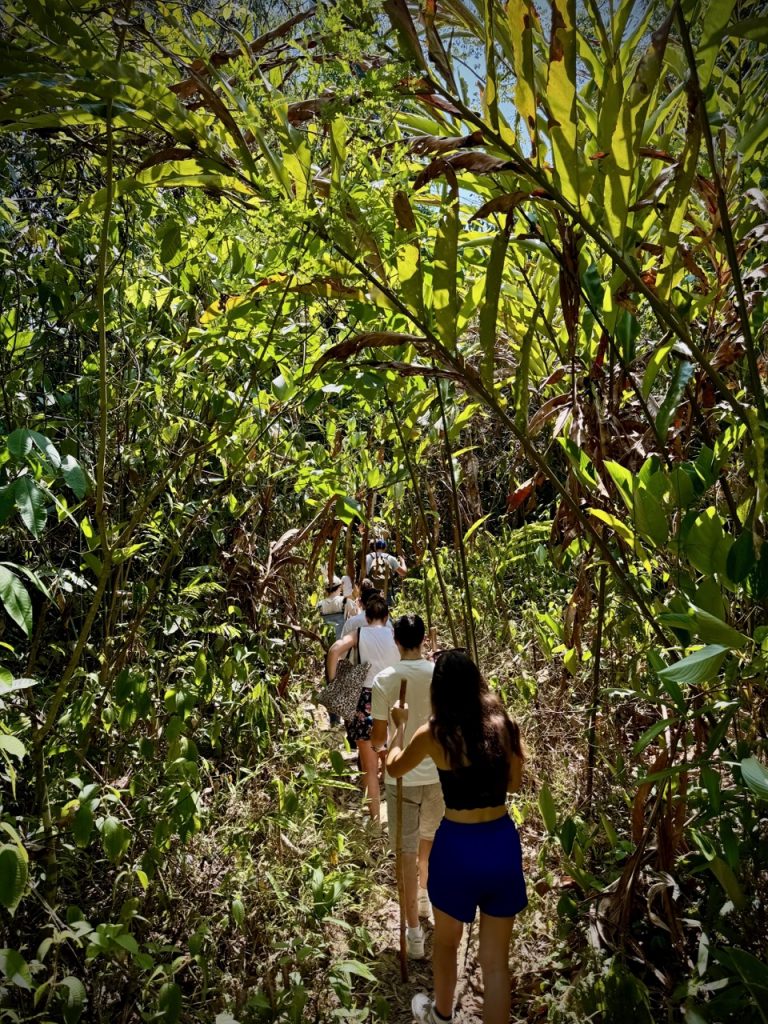
This was to be a walk, in a small group, through the jungle immediately surrounding the camp, which would end in a Thai food cooking demonstration in a small hut in the middle of the jungle.
The walk was pretty straightforward – easy enough for some young children who were also in our group, but still quite off-the-beaten-track with a bit of climbing up and down some steep sections – just enough to make it interesting.
It was absolutely boiling hot so we were grateful the walk was at a pretty gentle pace with plenty of stops to rest and take photos.
We were really hoping to see some more wildlife on this activity, having loved seeing those monkeys so much a couple of days beforehand.
Unfortunately it wasn’t to be and the only living animals we saw were a few bees and that was about it.
If we had just one slight disappointment with our time at Elephant Hills, I’d say it was that despite being in the heart of a jungle national park, in a country with such a huge amount of exotic wildlife, all we really encountered were the elephants and one group of monkeys that we saw on day one.
Those two encounters were brilliant but I guess we’d hoped we might see a bit more in the way of wildlife.
However this must be the trade-off between going deep into truly wild jungle territory – and the convenience and comfort of having a fully-catered camp to stay at.
Maybe much of the wildlife steers clear of the hundreds of tourists that visit the area every few days and if you venture into more remote parts of the jungle, you might encounter more jungle creatures.
But, as I mentioned above, in the remote jungle, there are no buffet breakfasts, lunches and all-you-can-eat dinners, with toilets, showers and a swimming pool to relax by at the end of each day!
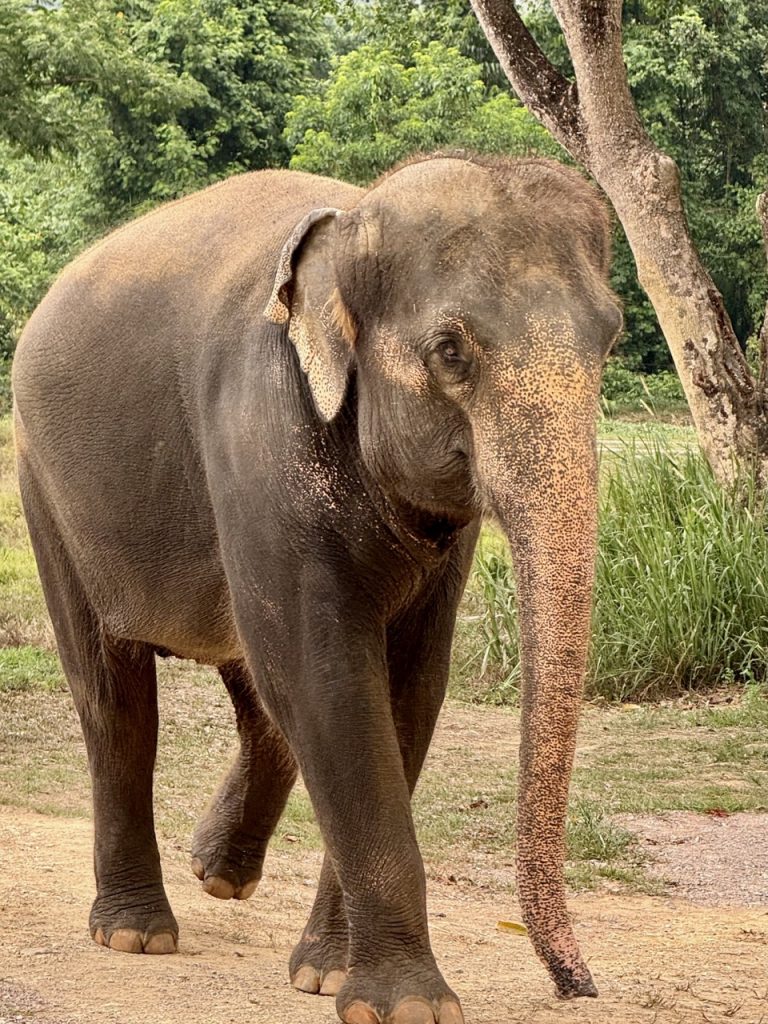
Our Elephant Hills stay ended just like it began – with a comfortable, smooth minibus ride all the way from the camp to the hotel we’d booked near the airport in Phuket ready for our journey back home the next day.
What we wanted from this trip around Thailand was a lot of variety – from the hectic city of Bangkok to the relaxing beaches and islands of Krabi and Phuket, to the remote jungle of Khao Sok national park – and Elephant Hills gave us that perfectly.
If you want to experience the amazing natural beauty of Thailand up-close, it’s a superb way of doing so; knowing you can spend time with elephants without worrying about their welfare; knowing you can walk, drive and kayak around the jungle in search of wild monkeys and other creatures – all whilst enjoying the comforts of fully-catered accommodation.
It was the perfect way to end our family trip around Thailand and we can definitely recommend it.
